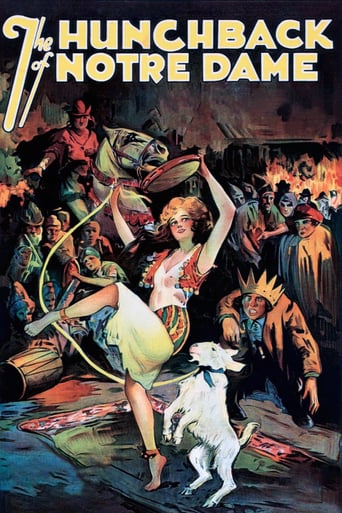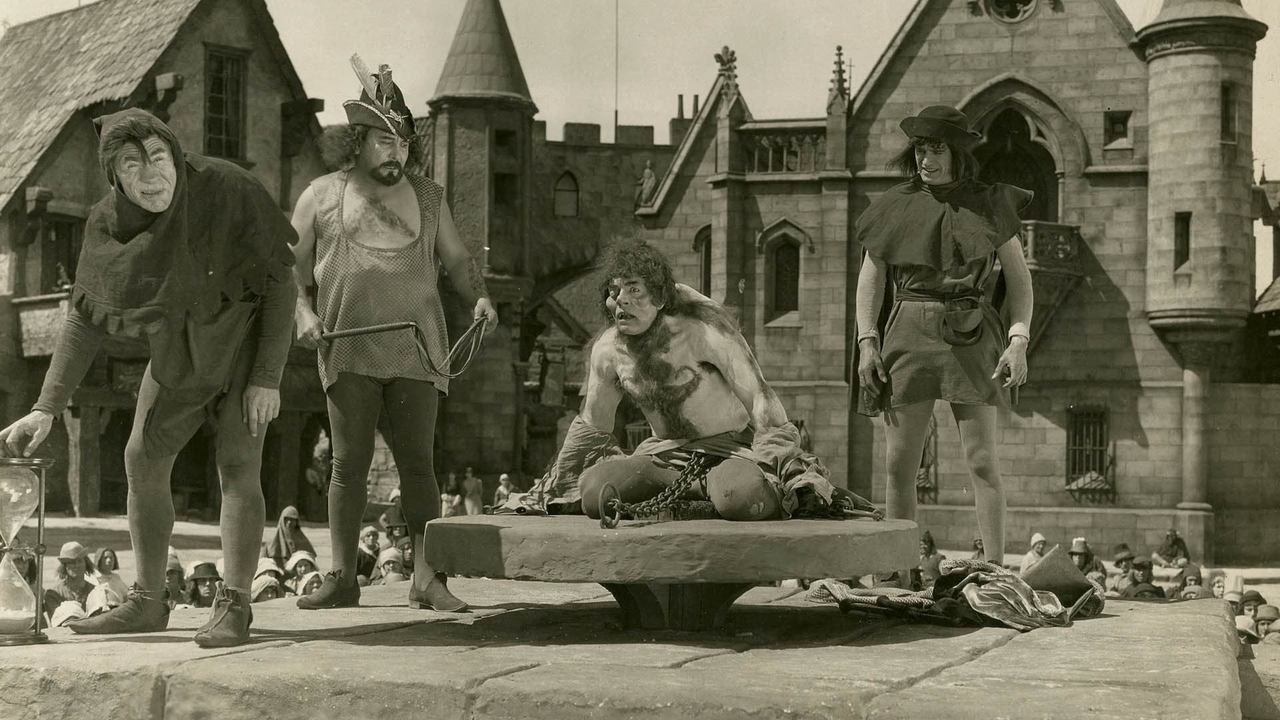Bonehead-XL
When I marathon the Universal Monster movies, this one usually ends up left out. If I was smart, I would say that "Hunchback of Notre Dame" isn't a horror film, instead a period melodrama. While Quasimodo is frequently featured next to Frankenstein and Dracula, the film is low on horror content. The truth is I remember disliking the movie and felt no reason to revisit it. Leaving "Hunchback" out all-together isn't fair though. After all, "Dracula" and "Frankenstein" wouldn't have happened without it.The movie is beholden to the conventions of Hugo and Laemmle. Despite getting title billing, the hunchback isn't featured in large portions of the film. The gypsy Esmeralda's love affair with the captain of the guard Phoebus takes up half the run-time. Hugo's themes of social unrest take stage in this subplot. Esmeralda's adopted father, Clopin, king of the gypsies, plots revolution against the apathetic king. His daughter falling in love with a noble doesn't sit well with the guy. The themes of the haves versus the have-nots are never more apparent then in the scene where Clopin and his thieves storm Phoebus' party. The poor stand on one side of the ballroom, clothed in rags, the rich on the other, in elegant gowns. Even Quasimodo is a gear in the machine of social hierarchy. The film's villain controls the hunchback. When the gypsy girl flares Frollo's lust, he forces Quasimodo to kidnap her. Caught by the guards, the deformed servant suffers for his master's crimes. The hunchback turning against his boss is indicative of the story's overall themes of revolt.Potentially interesting themes are undermined by the commitment to melodrama. Differing from the novel, Esmeralda is saved from the gallows. Following the novel, she is actually royalty, the daughter of a rich woman, kidnapped as an infant by gypsies, her birth mother driven mad by the lost. This information is delivered flatly by a very knowledgeable, exposition-prone bit player. Esmarelda's true identity as a princess doesn't affect the plot much. Frollo's villainous machinations and Quasimodo's rebellion are motivated by their passion for the girl. This would probably be fine if the character had more depth. Patsy Ruth Miller looks elegant but the character is pushed around by the whims of the plot. Phoebus, a cynical womanizer in the novel, is transformed into a bland romantic hero, practically obsessed with the girl. The story of class warfare gets lost amidst the romantic entanglements and period grandeur. Hugo's criticism of the Catholic Church is excised totally, Archdeacon Claude Frollo becoming a kind man of the cloth. The role of villain is shifted to his brother, Jehan. Despite this, Brandon Hurst's performance is a highlight, sneering and glaring from under his cap. Even Hurst gets a romantic moment, confessing his love to the girl in her dungeon prison.Even if he isn't the main character, Quasimodo is the most interesting character. Lon Chaney's performance is legendary. Performing under extensive make-up and a fifteen-pound silicon hump, he conveys pathos with only his body language. The moment when Esmarelda comes to the hunchback's aid as he suffers on the pillory is touching strictly because of Chaney, gratitude clearly visible on his face. Chaney vends the hunchback's love with longing looks, selling the romance better then the script can. Quasi's last act before he dies is to ring the bells, celebrating Phoebus and Esmarelda's love, another memorable moment. Chaney overacts at times, sticking his tongue out and grasping his hands. Still, his performance is probably the best thing about the film. Especially since Quasimodo's evolution to anti-hero is a bit rough. Dropping wooden pillars and boiling lead on innocent, rioting gypsies doesn't exactly endear him to the audience."Hunchback of Notre Dame" isn't a horror film but is still visually spectacular. The sets of Notre Dame are beautiful and moody, Gothic arches echoing through the entire church. The Court of Miracles is another fantastic set, teeming with life in cramped, rocky locations. People in ghoulish skeletons costumes dance out from under dark bridges. Deep shadows seal the eerie atmosphere. An extended visit to a torture chamber is another effective, horrific scene. Ultimately, these elements sell me on the movie, not the overwritten, routine story. I probably prefer Disney's version and the Charles Laughton take appears to be the most critically acclaimed but 1923's "Hunchback" endures for a reason.
st-shot
The first of the oft filmed Victor Hugo classic featuring Lon Chaney as Quasimodo is filled with early epic quality and some heavy duty overacting in supporting roles not to mention the frightful state of the print which unfairly detracts from the films overall quality.Lon Chaney is an impressive bell ringer but aside from a few acrobatic moments amid the gargoyle seems restricted in his oppressive costume and make-up. Along with Phantom of the Opera this may be Chaney's most famous role but I feel not one of his greatest performances. Ernest Torrence as Clotin, King of the Beggars is far more effective and memorable than Chaney's posings .William Worsley's direction offers little as the rest of the cast overacts and the film's tempo wavers and becomes disjointed (blame here may once again also be affixed to the horrendous shape of the print). When it comes to the big crowd scenes Worsley is no Griffith in building a fever pitch. Shying away from graphic violence and the unbridled rebellion DW puts together in Orphans of the Storm made two years earlier and dealing with the same locale. Worsley offers some neat overheads of Quasimodo's gargoyle eye view of things but some of his "massive crowd" scenes are sparse such as the scene of the impending execution of Esmeralda. It look's like the blood lusting rabble of Paris slept in that day as stragglers can be seen meandering up to the scaffold in what is normally a shoulder to shoulder SRO event. Historically significant The Hunchback of Notre Dame deserves attention but when put into context by comparison with the other epic of that year (Orphans) you wonder what the hullabaloo was all about in the first place.
mhesselius
I saw the Hunchback the other day, and when Lon Chaney is on screen, which isn't nearly enough, you can see why he is considered by some to be the greatest actor of silent film. As the grotesque bell-ringer Quasimodo, Chaney's pantomime shows the complexity of a man with a beautiful soul imprisoned within a contorted form, fated to hate the world that sees him as a freak. Chaney's make-up is as usual superb. The rest of the cast doesn't fare as well.Second best is Patsy Ruth Miller. Pretty and petite, her performance is natural and understated, but she's the girl-next-door, and doesn't possess the sex appeal required of the role of the dancing-girl Esmaralda. Ernest Torrence as Clopin, and Raymond Hatton as Graingoire are adequate. The other featured players are awful. Norman Kerry as Phoebus, and Brandon Hurst as the villain Jehan are stock characters out of melodrama, types that give silent film an undeserved reputation for always being florid and stagy. Blame director Wallace Worsley and the writers for not demanding the same complexity of other characters as Chaney brings to the Hunchback. The results are often unintentionally humorous, as when Hurst strides into a scene with his cloak thrown over his face, and when Kerry rakishly bares Esmaralda's shoulder, but repents and, with a pained look of remorse, covers it up again.Set design is impressive and real—no CGI. Notre Dame Cathedral is an actual prop with gargoyles and statues that Chaney climbs on. But the sets are unimaginatively used by Worsley. There are no perceptible lighting effects. Exterior daylight scenes weren't shot in the studio, but always outside in bright sunlight and were sepia-tinted. Blue-tinted exterior night scenes were actually shot at night (unusual for the time) as the vapor on the actors' breath shows.Anyone acquainted with the novel will also realize that this adaptation is sub-par. For instance, how does Esmaralda's mother know gypsies stole her child? There were no witnesses. In the novel gypsies leave the hunchback in her place. Why is the Hunchback the slave of Jehan? We have no background information to explain their relationship. And what's Gringoire's purpose other than as a messenger from Esmeralda to Phoebus? In the film Phoebus is a conventional romantic hero, not the selfish, lascivious rogue as in the book. Chaney achieves pathos with his character, but audiences in 1923 could never stomach the novel's grand tragic ending in which Esmaralda dies. Also, fear of offending the church caused Universal to make the villain not a priest but the saintly priest's brother, who in the novel is an amiable chap.Some may be interested in this as an early horror film. But although there are elements of horror in the original story, Worsley's uninspired direction leave those avenues unexplored. The dark, Gothic atmosphere of the story would have to wait for German émigré director William Deiterle and cinematographer Joe August, who created a shadowy nightscape for the 1939 film. Nevertheless, it is nice to see a new print of this film which, although still scratchy, reveals much more detail, and moves at the correct projection speed, giving us a better idea of how the film originally looked.
lepoisson-1
This movie is an awesome production from start to finish. When there's a mob scene, it's a full tilt mob. The "Court of Miracles" is really populated by hundreds of Paris' "down and outs." Watching the hunchback navigate the façade of Notre Dame is breathtaking. Universal spared nothing making this picture, and it shows. And of course, Lon Chaney as the hunchback was both believable and repulsive.I cannot add much that hasn't already been said. I cannot recommend this movie highly enough, from viewpoints of both historical importance and pure entertainment. Finally, I recommend checking out Charles Laughton as the hunchback in the 1939 version; it too is a superb interpretation of Hugo's novel.


 AD
AD






